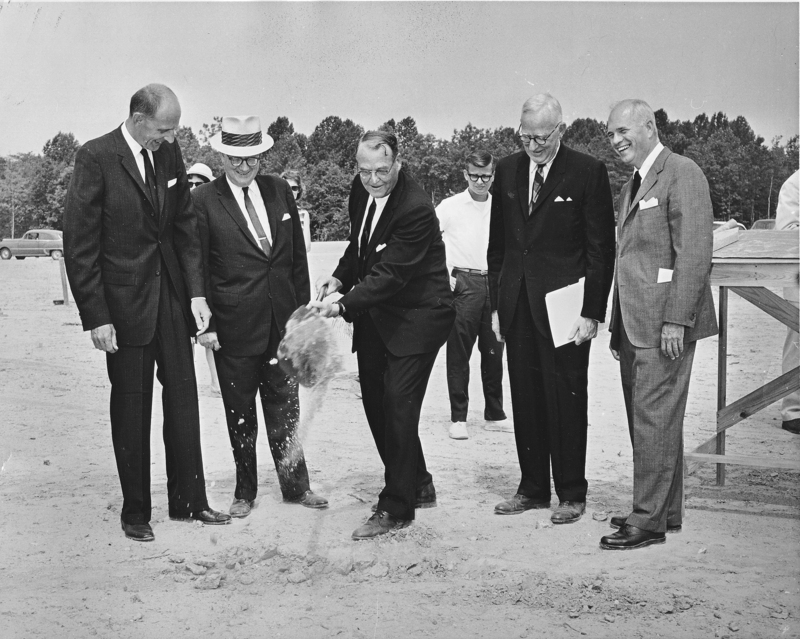Northern Virginia Lawmaker and Voluntary Segregationist
Fenwick was an effective legislator with clearly specified policy priorities. He ardently advanced the cause of mass transit. Fenwick advocated for the DC Metro and its extension to Falls Church, Vienna, and Fairfax. He believed in appropriating revenues to improve the treatment of people with mental illnesses. A lieutenant colonel in the Judge Advocate Corps during World War Two, Fenwick coordinated with veterans of the US House of Representatives to tap appropriations for the defense industry of Northern Virginia.[1] As the Civil Rights Movement increasingly won judicial victories, Fenwick also sponsored bills that restricted the scope of racial integration in the Commonwealth’s public schools. He rejected federal intervention in state education, preferring instead “local-option plans” facilitated by elected officials. In an era defined by Jim Crow statutes, white Virginia politicians made crucial decisions about how their public schools would continue to reflect entrenched patterns of discrimination. In essence, Fenwick favored an indeterminant “period of time during which children should be able to attend segregated schools on a voluntary basis.” This ideological position may not have been provocative in wealthy suburban Arlington during the 1950s, but by the 1960s it was instigating contentious debate practically everywhere. Senator Fenwick was not known to shy away from these controversies.[2]
Fenwick, the voluntary segregationist, teamed up with his good friend Charles Harrison Mann, another conservative Democrat from Arlington, to oppose mandated racial integration of public schools. C. Harrison Mann was a Virginia House Delegates and, like Fenwick, served in World War Two. They were members of the GMC Advisory Committee. Long ago Mann’s great-great-great grandfather, William Buckland, worked for the college’s namesake, George Mason IV, spending many a day with the American Founder on a property overlooking Potomac waters. Once an indentured servant, Buckland honed his talents as a carpenter in the colonial Chesapeake region. Mason IV chose him to be the artisanal architect of Gunston Hall. Buckland’s “master carvings” survive today as interior details of plantation homes designated for historic preservation.[3] Fenwick and Mann were also master planners and builders of Northern Virginia. Arguably, their crowning site of construction was George Mason College, as this summer 1963 image of a groundbreaking campus ceremony (below) illustrates.
The black-and-white photograph depicts five men in suits. Charles Fenwick, the patent attorney and state senator, shovels dirt. Harrison Mann, the great-great-great grandson of William Buckland and Arlington Delegate, smiles broadly on the far right next to a table. Between these two lawmakers is the Director of George Mason College, John Finley, holding a folder. The former chair of the GMC Advisory Committee, Clarence Steele, wears a hat. Flanking Steele at the end is the Fairfax City Mayor John Wood. Close to this bulldozed site a major library would be erected.[4]
[1] Washington Post, Mar. 2, 1950; June 27, 1957; Royce Hanson and Harold Wolman, Nation’s Metropolis: The Economy, Politics, and Development of the Washington Region (Philadelphia: University of Pennsylvania Press, 2023), 184, 187; Zachary Schrag, The Great Society Subway: A History of the Washington Metro (Baltimore: Johns Hopkins University Press, 2006), 96-99, 103. Charles Fenwick’s ties to Congressional Democrats: James Sweeny, “A Day in the Old Dominion: The 1964 Presidential Election,” The Virginia Magazine of History and Biography 102, 3 (1994), 316, 324. Charles Fenwick was a combatant in World War I, serving in the US military’s tank corps: Washington Post, Feb. 23, 1969.
[2] Washington Post, July 23, 1949; Aug. 26, 1956; https://encyclopediavirginia.org/entries/fenwick-charles-r-1900-1969/ [Accessed Feb. 7, 2023]. Senator Fenwick was wary of Massive Resistance in Virginia, particularly after the laws underpinning this insurgent white supremacist movement were declared unconstitutional by the United States District Court for the Eastern District” of the Commonwealth: No author, Current Trends in Negro Education and Shorter Papers: Section A: Virginia’s ‘Massive Resistance’ Laws Declared Unconstitutional,” Journal of Negro Education 28,2 (1959), 163-72; see also: Brian Daughterity, Keep On Keeping On: The NAACP and the Implementation of Brown v. Board of Education in Virginia (Charlottesville: University of Virginia Press, 2016), 60-78; Ira Lechner, “Massive Resistance: Virginias’s Great Leap Backward,” Virginia Quarterly Review 74, 4 (1998), 631-40.
[3] https://gunstonhall.org/house-grounds/the-house/architect/; https://en.wikipedia.org/wiki/C._Harrison_Mann [Accessed Feb. 15, 2023]; Rosamond Beirne and John Scarff, William Buckland 1734-1774: Architect of Virginia and Maryland (Baltimore: The Maryland Historical Society, 1958), 158-59.
[4] The August 1963 photo can be sourced in University Libraries, Special Collections, George Mason University Photograph Collection, Box 1, Folder 9.
Kyle Filter
